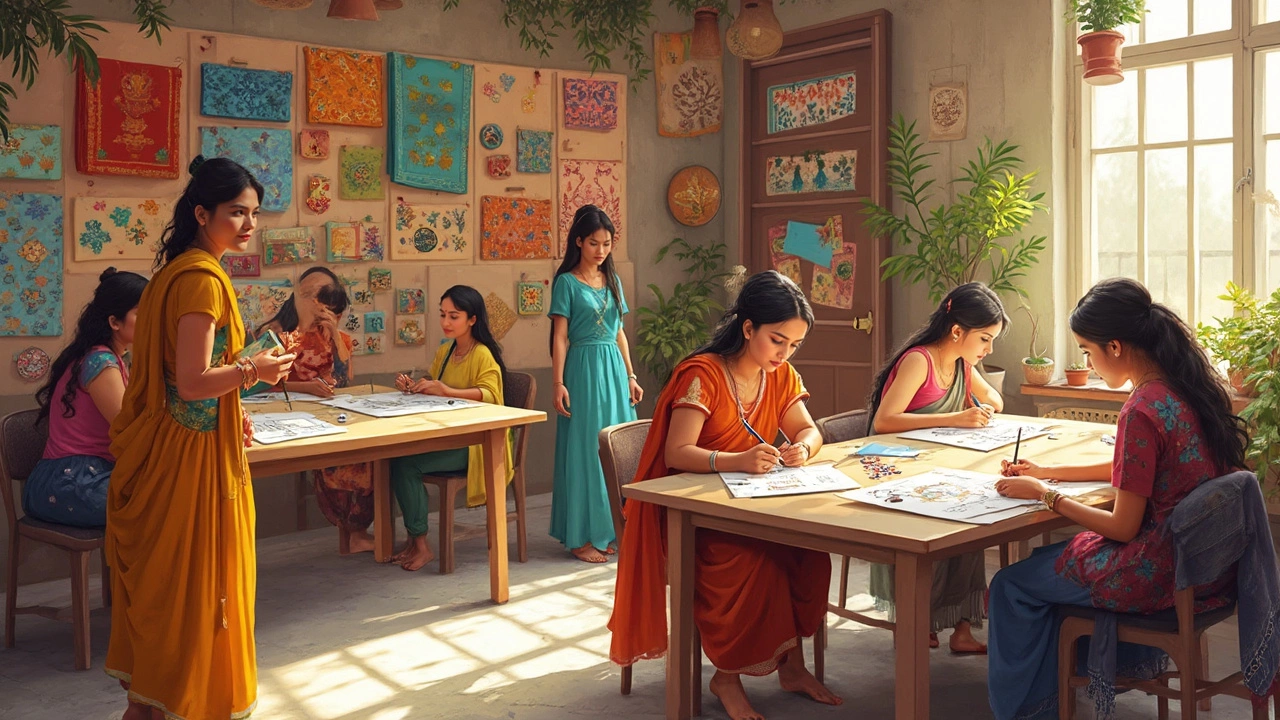
Diplomas in India can be a game-changer if you're looking to boost your career without spending years in a traditional degree program. They're like compact, targeted educational packages that focus on giving you the skills you need for specific jobs. So, if you're wondering whether to dive into the sea of diplomas, let's chat about what they really are and how they can work for you.
Picking a diploma course often means diving straight into hands-on learning. Unlike your typical grind of four-year degrees, diplomas are all about practical training. Whether you're eyeing engineering, IT, fashion design, or even hospitality, there's usually a diploma for it. And the best part? These programs usually wrap up within one to three years, getting you job-ready faster.
Cost is another biggie. Degrees can be expensive, but diplomas let you dodge that bullet to some extent. They often cost less, which is a relief if you're stepping out into the adult world without a financial safety net. Plus, the quicker turnaround means you're out there earning sooner rather than later.
- Understanding Diplomas
- Why Choose a Diploma?
- Popular Diploma Fields
- Duration and Format
- Cost Considerations
- Career Paths After a Diploma
Understanding Diplomas
In India, a diploma course is essentially a short-term program focused on providing practical and industry-specific skills. These courses are designed to offer specialized knowledge and hands-on experience in a particular field, making them highly valued by employers. Most diploma programs don't just stick to academic theories; they dive deep into practical applications, which is super helpful if you want to get a job quickly.
Diploma courses are popular in many fields like engineering, information technology, hospitality, and design. They're typically open to students who have completed their 10th or 12th grade, depending on the program's requirements.
Another cool thing about diplomas is their flexibility. They are offered through various institutes across India, including polytechnic colleges, community colleges, and even some universities. Each institution has its own set of rules for admission, but they generally focus on students’ marks in prior educational levels.
What's interesting is that these courses can range from 6 months to 3 years. For example, a diploma in engineering often lasts three years if started after 10th grade. Shorter programs, like those in graphic design or culinary arts, can be completed in less than a year.
For those who are curious about the numbers, here's a quick snapshot on diploma enrollment statistics:
| Year | Enrollment (approx. in lakhs) |
|---|---|
| 2021 | 5.4 |
| 2022 | 5.8 |
| 2023 | 6.1 |
These numbers reflect how more and more students are realizing the benefits of choosing diploma programs as a stepping stone to kickstart their careers. So, if a streamlined, cost-effective education route sounds good to you, a diploma might just be what you’re looking for!
Why Choose a Diploma?
Opting for a diploma course in India is like taking the express lane to employment. Let's break down some of the reasons why you might want to consider this path over a traditional degree.
Firstly, diplomas are incredibly focused. These courses emphasize practical skills tailored to specific industries, which means you're not just learning theory—you're actually getting hands-on experience. Whether it's in fields like engineering, IT, or hospitality, you'll find the coursework is designed to prepare you for real-world challenges.
There's also the time factor. In a world where time equals money, a diploma can be a quicker journey to starting your career. Many programs take just one to three years, which is great if you're itching to jump into the workforce sooner. This efficiency can also lead to faster overall life advancement; you're earning, learning, and growing at a pace that's less drawn out than traditional routes.
Cost is another compelling reason. Higher education can be expensive, and for many, a four-year degree isn't financially feasible. Diplomas often come at a fraction of the cost, allowing you to dodge hefty student debt.
Unemployment rates and industry demand also tell a story. In India, sectors like IT, engineering, and healthcare regularly report skill shortages. Diplomas can sometimes better align with these gaps compared to more general degree programs.
Let's look at some quick stats:
| Field | Average Duration | Cost Range (INR) |
|---|---|---|
| Engineering Tech | 2-3 years | 30,000 - 2,00,000 |
| Information Technology | 1-2 years | 40,000 - 1,50,000 |
| Hospitality Management | 1.5-2 years | 50,000 - 1,00,000 |
This snapshot shows how diverse the offerings are, fitting different timelines and budgets. So, if you're eager for direct entry into industries that value specific skills, a diploma might just be your ticket to a promising career.
Popular Diploma Fields
There's a crazy variety of diploma courses in India to suit pretty much any interest. Whether you're technical-minded or have a creative flair, there's probably a course that's got your name written all over it.
Diplomas in engineering are a big hit. Specialties like civil, mechanical, and electrical engineering offer practical skills that can secure you a job in various sectors. These programs focus heavily on real-world applications, so you're not just learning theory but actually getting hands-on experience.
If tech is more your scene, IT and computer applications diplomas are solid choices. With the tech industry booming and constantly evolving, these programs can set you up for roles in everything from software development to network administration.
For the creatively inclined, design diplomas cover fields like fashion design, graphic design, and interior design. These programs are great for nurturing artistic skills while also teaching you about the business side of the industry—talk about a two-for-one deal!
Healthcare is another area where diploma holders are in demand. Programs in nursing, medical lab technology, and pharmacy can lead to essential roles in hospitals and clinics. These courses usually include both classroom learning and internships to ensure you get real, clinical experience.
Lastly, if you're passionate about hospitality, look into hospitality and hotel management diplomas. With tourism on the upswing, these programs prepare students for roles in hotels, resorts, and travel agencies.
If you're curious about the numbers, consider the following table showcasing the typical duration and fees for some popular fields:
| Field | Duration | Average Fees |
|---|---|---|
| Engineering | 3 years | ₹ 30,000 - 50,000 per year |
| IT & Computer Applications | 1-2 years | ₹ 20,000 - 40,000 per year |
| Design | 1-3 years | ₹ 25,000 - 60,000 per year |
| Healthcare | 2-3 years | ₹ 50,000 - 80,000 per year |
| Hospitality | 1-3 years | ₹ 40,000 - 70,000 per year |

Duration and Format
When it comes to diploma courses in India, they tend to be short and sweet—ideal if you want a no-fuss route to new skills and job opportunities. Typically, these courses can run anywhere from six months to three years. The exact duration will depend on the field of study, course content, and the particular educational institution you're attending.
Diplomas are all about the hands-on experience, focusing on practical skills more than theory. That’s probably why many students find them appealing. They’re designed to get you career-ready in a jiffy. For example, an engineering diploma might last three years, while something in the fashion design world might only take a year. Fast, right?
Day-to-day, you might find yourself juggling classes that range from workshops, seminars, practical labs, to even some group projects. It's almost like a mix-and-match of learning experiences that equip you for real-world situations.
"Diploma courses fast-track the journey of turning students into skilled professionals," says Dr. Anita Kumar, head of academic affairs at a leading Indian institute.
Now, let’s give online diplomas a shout-out. They're gaining popularity because of their convenience factor. With e-learning platforms, students can take classes at their own pace, making it super flexible for those who need to balance study with work.
So, if you're eyeing a diploma program as a quick ticket to a job or new career skills, you've got options that are flexible, cost-effective, and focused.
Cost Considerations
Choosing diploma courses in India is a smart move if you're keeping a close eye on your budget. When stacked up against degree programs, diplomas are usually lighter on the pocket. This makes them a solid choice if you're looking to gain skills without draining your savings.
The tuition fees for diploma programs vary widely depending on the field and institution. For example, expect to pay anywhere from INR 10,000 to INR 50,000 annually for technical diplomas, especially in sectors like engineering or IT. This is pretty reasonable compared to the hefty fees of degree courses which can easily run into lakhs per year.
If you're considering government-affiliated polytechnic colleges, you're in luck. These institutions often have subsidized fees. Plus, there are numerous financial aid options available, like scholarships and educational loans, which can further ease the financial burden.
Here's a quick look at what you might expect to spend:
| Field | Annual Fees (Approx.) |
|---|---|
| Engineering | INR 15,000 - INR 30,000 |
| IT & Computer Science | INR 10,000 - INR 25,000 |
| Fashion Design | INR 20,000 - INR 40,000 |
| Hotel Management | INR 15,000 - INR 35,000 |
Remember, while you're shelling out less upfront, you might also need to budget for materials or lab equipment, depending on your course. But, with a bit of planning and these more affordable options, pursuing higher education in India can be less daunting for your wallet.
Career Paths After a Diploma
So, you've got a diploma in hand, and you're ready to step into the real world. What comes next? Well, having a diploma opens up several avenues for gainful employment and further studies. Let's break down how you can leverage your diploma into a rewarding career.
Many industries in India value the hands-on skills you gain through diploma courses. Whether it's in engineering, design, or hospitality, employers are constantly on the hunt for people who can hit the ground running. For instance, if you've completed a diploma in mechanical engineering, roles as a technician or a junior engineer could be on the table.
The perks don't stop there. Many diploma holders choose to flesh out their education by continuing studies. For instance, you could channel your diploma credits into a lateral entry, joining the second year of a bachelor's degree. This not only boosts your qualifications but also opens doors to managerial positions down the line.
That being said, salary expectations on entry might be modest compared to degrees. However, the practical experience often means that diploma holders climb the ladder swiftly as they prove their capabilities on the job. For those who’ve completed diploma courses in management or business, a quick leap into entrepreneurship isn't out of the question either.
- Engineering: Technicians, Junior Engineers
- Design: Assistant Designers, Draftsmen
- IT: System Analysts, IT Support
- Hospitality: Front Desk Managers, Chefs
In some cases, especially in creative fields, diplomas provide the foundation to start your own gig. Think graphic design or fashion – your diploma could be your ticket to freelance work or even starting your own brand.
Ultimately, the career path you choose will depend on your interests. But no matter the choice, a diploma prepares you with the practical, not just theoretical, tools needed to get started and advance in whichever field you select.
